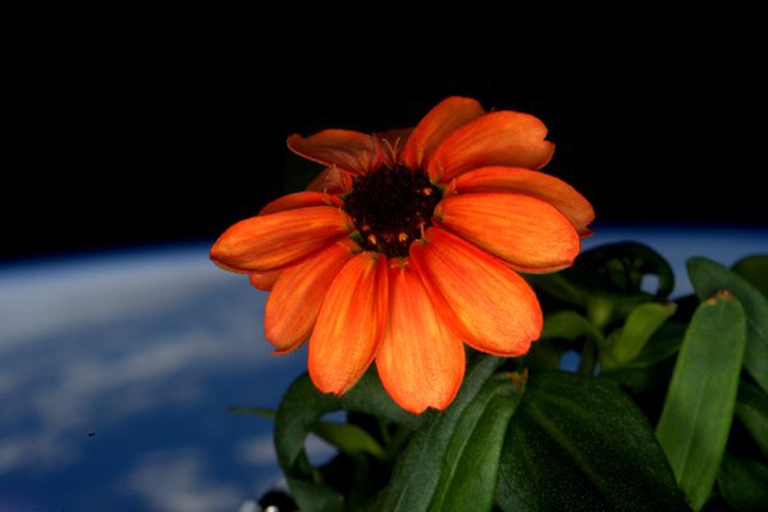
Our species took its first steps in a world covered in trees. Today, forests offer us sustenance, shelter, and clean the air that we breathe.
L’astronauta Scott Kelly ha pubblicato la foto della prima zinnia sbocciata nello spazio. Segno che anche i fiori possono crescere in condizioni di microgravità.
After the lettuce grown in the International Space Station (ISS), it’s now time for flowers, or better, zinnias. Astronaut Scott Kelly has posted the pictures of a zinnia flower with orange petals, bloomed at 400 kilometres from the Earth.
The experiment, carried out to better understand how plants react to microgravity conditions, with humidity and light situations extremely different from the Earth, will be useful to draw up a sort of textbook on cultivation and growth of edible vegetable species, also in preparation for the next journeys to Mars.
As in Andy Weir’s novel, The Martian, where the protagonist is forced to grow plants to survive, practicing what is defined “autonomous gardening” will be crucial for astronauts.
Why zinnias? “The zinnia plant is very different from lettuce,” Trent Smith, the veggie project manager. “It is more sensitive to environmental parameters and light characteristics. It has a longer growth duration between 60 and 80 days. Thus, it is a more difficult plant to grow, and allowing it to flower, along with the longer growth duration, makes it a good precursor to a tomato plant.”
The entire experiment has been told on NASA’s website. Astronauts underwent moments of discouragement, as the plants often suffered the excessive humidity (with the formation of mould) and the lack of water.
By Christmas Eve, Smith said he thought the plants needed more water, and he didn’t comply with the team’s watering schedule. “You know, I think if we’re going to Mars, and we were growing stuff, we would be responsible for deciding when the stuff needed water. Kind of like in my backyard, I look at it and say ‘Oh, maybe I should water the grass today.’ I think this is how this should be handled,” he said.
First ever flower grown in space makes its debut! #SpaceFlower #zinnia #YearInSpace pic.twitter.com/2uGYvwtLKr
— Scott Kelly (@StationCDRKelly) 16 Gennaio 2016
This is what these kinds of experiments are for: finding out what doesn’t work and trying to understand how to figure it out. And this is exactly what astronauts did, allowing the first zinnia flower to bloom in space. Its orange petals seem to be painted on a black, deep canvas, with a blue pearl on the background: the Earth.
Siamo anche su WhatsApp. Segui il canale ufficiale LifeGate per restare aggiornata, aggiornato sulle ultime notizie e sulle nostre attività.
![]()
Quest'opera è distribuita con Licenza Creative Commons Attribuzione - Non commerciale - Non opere derivate 4.0 Internazionale.
Our species took its first steps in a world covered in trees. Today, forests offer us sustenance, shelter, and clean the air that we breathe.
Though eating is a primary necessity for astronauts, it doesn’t mean it’s necessarily a pleasure. The first meals eaten in space were flavourless, odourless and lacked consistency. But times have changed, and a healthy, balanced, and tasty diet is essential for astronauts to go through long periods at the International Space Station, without negative impacts
Juno probe will turn around the gas giant for around 20 months, before disintegrating into the atmosphere.
Poachers in Africa are encroaching on wildlife land and killing rhinos in travel hot spots now devoid of visitors due to the coronavirus pandemic.
Actor and environmental activist Leonardo DiCaprio has contributed two million dollars to a fund to protect Virunga National Park in Congo from threats such as terrorism, the coronavirus and poaching.
For the first time in seventeen years, Iceland’s two main whaling companies won’t resume whale hunting. The announcement concerns this year’s season but could carry into the future.
The relationship between the coronavirus and wildlife is complex: while the pandemic may lead to a reduction in the illegal trade in wild animals, it may also encourage it in other respects.
The largest coral reef in the world is severely threatened by climate change, but researchers are developing strategies that could contribute to saving the Great Barrier Reef.
NGO Free the Bears has opened a mountain sanctuary for moon bears in Laos. With the government’s help, it aims to close all bile farms by 2022.









